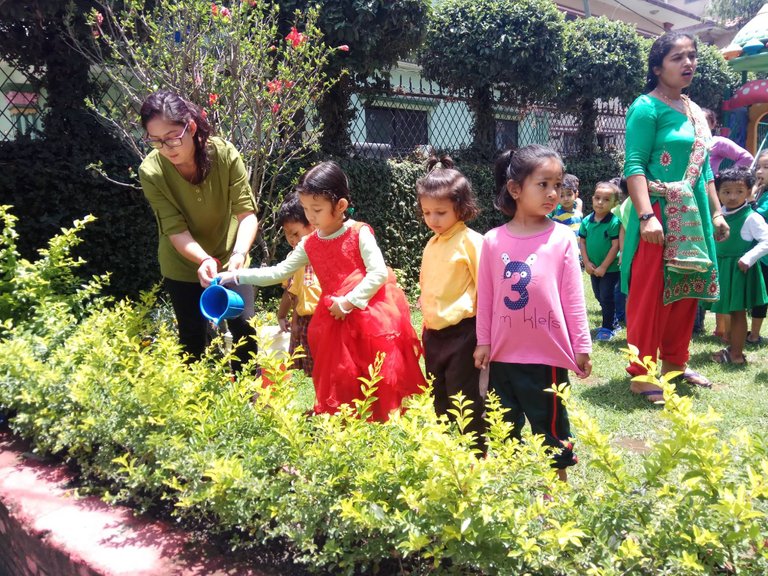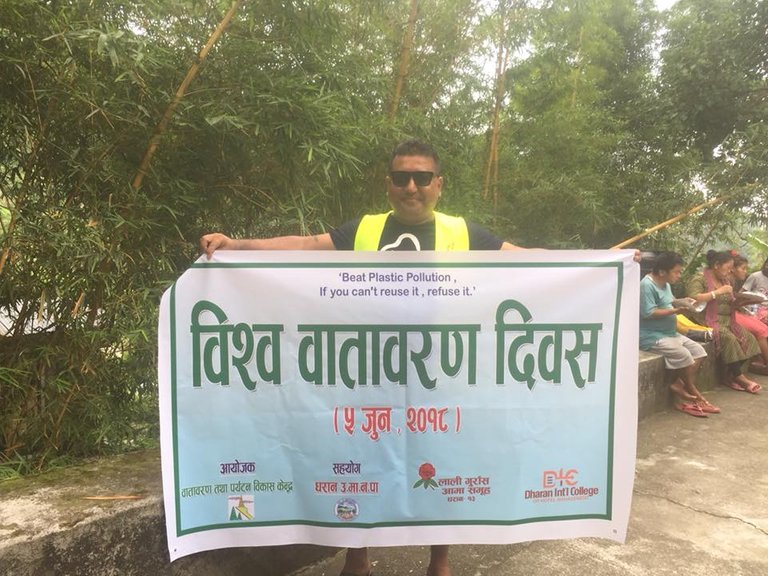
UN World Environment Day also called Eco Day occurs on 5th June every year which is the United Nations principle vehicle for encouraging awareness and action for the protection of our environment. since,1974 awareness on environmental issues from marine pollution, human over population,and global warming to sustainable consumption and wildlife crime.
The world environment day has been accomplished with the following thems raising awarness,supporting action and driving change.
"plan for planet":2005#"don't desert dry lands": 2006#"Melting ice a hot topic":2007#" CO2 kick the habit towards low carbon economy":2008#"your planet needs you_unite to combact climate change":2009#"many species ,one planet one future":2010#"forest-nature at your service"2011#"Green economy -does it include you?:2012#"think ,eat ,save":2013#"International year of small islands developing states(SIDS)":2014#"seven billion dreams -one planet":2015#"Go wild for life":2016#"connecting people to nature in the city and on land from the poles of equator":2017#"Beat plastic pollution":2018
Celebrating environment day by planting
Whether you live in an urban megacity or rural farmland, you surely see plastic bags blowing around anytime you leave the house.
Some blow across roads like post-apocalyptic tumbleweed, while others become snagged in the branches of street trees. Still others end up floating through our creeks and rivers until they find their way to the sea.
But while these plastic bags are certainly not pretty, they actually cause real, tangible harm to the greater environment.
Plastic bags tend to disrupt the environment in a serious way.
They get into soil and slowly release toxic chemicals. They eventually break down into the soil, with the unfortunate result being that animals eat them and often choke and die.
Below, we’ll examine a few of the most significant problems they cause and discuss the extent of the problem.
Environmental Damage Caused by Plastic Bags
Plastic bags cause several different types of harm, but three of the most troubling problems they present include the following:
Wildlife Harm
Animals suffer harm at the hands of plastic bags in a number of ways.
Many animals – including both terrestrial and aquatic varieties – eat plastic bags, and suffer from serious health problems once they do.
A significant number of cows, for example, die each year after eating plastic bags that end up in their grazing grounds. This has been a particularly big problem in India, where cows are numerous and trash-collection sporadic.
Upon surgical examination, many of the cows injured by this plastic plague are found to have 50 or more plastic bags in their digestive tracts.
Animals who swallow plastic bags often suffer from intestinal obstructions, which typically lead to a long, slow and painful death. Animals can also be poisoned by the chemicals used to create the bags, or from chemicals that the plastic has absorbed while making its way through the environment.
And because plastic doesn’t break down very readily in the digestive tracts of animals, it often fills their stomachs. This causes the animals to feel full, even while they slowly waste away, eventually dying from malnutrition or starvation.
But while livestock and domestic animals are certainly at risk from plastic bags, some animals are suffering even greater harm.
Already stressed by habitat destruction, decades of poaching and climate change, sea turtles are at particular risk from plastic bags, as they often mistake them for jellyfish – a popular food for many sea turtle species.
In fact, researchers from the University of Queensland recently determined that approximately 52 percent of the world’s sea turtles have eaten plastic debris – much of it undoubtedly originating in the form of plastic bags.
microplastics
Microplastic fibers identified in the marine
Clogged Sewage Systems
Even in urban areas, where wildlife is relatively scarce, plastic bags cause significant environmental harm. Runoff water collects and carries discarded plastic bags and ultimately washes them into storm sewers.
Once in these sewers, the bags often form clumps with other types of debris, and ultimately block the flow of water.
This prevents runoff water from properly draining, which often inconveniences those living or working in the area.
For example, roads often flood when storm sewers become blocked, which forces them to be closed until the water drains.
This excess water can damage cars, buildings and other property, and it also collects pollutants and spreads them far and wide, where they cause additional damage.
Clogged storm sewers can also disrupt the water flow throughout local watersheds. Blocked sewer pipes can starve local wetlands, creeks and streams of the water they require, which can lead to massive die-offs and in some cases, total collapse.
Aesthetic Deterioration
There isn’t much of a debate about the aesthetic impact plastic bags have on the environment.
The vast majority of people would agree that plastic bags ruin the appearance of just about every imaginable habitat, from forests and fields to deserts and wetlands.
But, this aesthetic deterioration isn’t a frivolous concern; it can actually have a significant impact on human health, culture and the economy.
Scientists have long known that views of natural landscapes provide a wealth of benefits.
Among other things, natural habitats and greenspaces help to reduce recovery times and improve outcomes of hospital patients, they help to improve focus and concentration among children, they help to reduce crime and they help to increase property values.
But when these same habitats are littered with plastic bags and other types of debris, these benefits are reduced.
Accordingly, it is important to value the aesthetic value of natural habitats, take steps to reduce plastic bag pollution and address these issues when developing public policy.
The Extent of the Problem
It is difficult to grasp the scope of the plastic bag problem, despite the ubiquity of plastic bags in the landscape.
No one knows exactly how many bags are littering the planet, but researchers estimate that 500 billion used around the globe each year.
A small percentage of these end up being recycled, and some people try to reuse old plastic bags for other purposes, but the vast majority of plastic bags are used a single time. Many are discarded into the trash, but a significant percentage end up polluting natural habitats.
Part of the reason that plastic bags are so problematic relates to their long lifespan.
Whereas a paper towel breaks down in a month, and a piece of plywood may take a year to degrade, plastic bags persist for much longer – typically decades, and in some cases centuries.
In fact, plastic bags that make their way into rivers, lakes or oceans never completely biodegrade. Instead, they break down into smaller and smaller pieces, eventually becoming “microplastics,” which are less than 5 millimeters long.
But although these microplastics aren’t as visually intrusive as plastic bags, they still cause a number of problems for wildlife and the ecosystem as a whole.
As you can see, plastic bags are a significant environmental concern.
As a species, we’ll need to carefully examine the challenges they present and implement strategies that are likely to reduce the amount of environmental damage they cause.
We’d love to hear your thoughts on the issue.
What types of steps would you recommend we take to help limit the damage caused by plastic bags?
There are three major forms of plastic that contribute to plastic pollution: microplastics as well as mega- and macro-plastics. Mega- and micro plastics have accumulated in highest densities in the Northern Hemisphere, concentrated around urban centers and water fronts. Plastic can be found off the coast of some islands because of currents carrying the debris. Both mega- and macro-plastics are found in packaging, footwear, and other domestic items that have been washed off of ships or discarded in landfills. Fishing-related items are more likely to be found around remote islands.These may also be referred to as micro-, meso-, and macro debris.
Plastic debris is categorized as either primary or secondary. Primary plastics are in their original form when collected. Examples of these would be bottle caps, cigarette butts, and microbeads. Secondary plastics, on the other hand, account for smaller plastics that have resulted from the degradation of primary plastics.
When going to the store and you buy a six pack of any kind of bottles or cans they normally have this plastic holding them together. The name of this device is called a six-pack holder. This plastic is killing animals and people may not even realize that it is happening. It can get wrapped up in bird’s wings. It also can get stuck around turtle’s shells and make them deformed. As well as any other kind of animal that comes along could potentially be in danger of getting tangled up in them. There have been photos of seals with six pack rings cutting into their necks. Not only are marine animals at risk but also land animals. Opossums, raccoons, and skunks are just a few on the list. There is brewery named Saltwater Brewery that has made a change in their product. They have designed the first ever 100% edible six pack ring. These rings are made up of barley and wheat remnants. Katie Dangerfield informs us that “The world’s oceans will have more plastic than fish by 2050”. Dangerfield also discusses “8 million tons of plastic ends up in the ocean each year. That is the equivalent to one garbage truck per minute and at that rate it could increase two trucks per minute by 2030 and four by 2050”.
People will let balloons go up into the air for a loved one that have passed. In all reality the balloons do not go up to “heaven.” They simply pop or just or just float back down to the ground. In some cases, they will end up in our sea or back onto the earth. Even children getting balloons and accidentally letting them go is causing problems. Patrick Sciacca notes that “More than 1,248,892 pieces of balloon litter have been removed from the worlds beaches in the past 25 years”. That is just coming from the land. Think about all the balloon pieces that are floating around in our waters. Patrick also informs that “several years ago a sperm whale was found dead from starvation because the mammal ate a Mylar balloon that lodged inside its stomach preventing it from eating”. If a single balloon can starve a whale, the biggest creatures on the planet, then what can it do to all the other marine animals?
STOP THROWING POLYBAGS IN RIVERS IN THE NAME OF GOD
There are many people who throw flowers, money, food, coconuts wrapped in plastic polybags in rivers like BAGMATI and KOSHI after performing various poojas. This is one of the major reasons that river BAGMATI has become polluted so drastically over the few decades.
CUT DOWN PERIOD WASTE
Switch to pads that are bio-degradable. Cotton pads help in cutting plastic pollution and are quite cheaper in comparison to the non-biodegradable pads.
Brands like Sakhi, Saathi and Suvidha sell organic pads in NEPAL
CARRY REUSABLE WATER BOTTLES
Instead of buying water bottles every day, you can switch to a dedicated reusable bottle for carrying water.
SAY NO TO STRAWS
Straws are unnecessary as they are not reusable, it is a one-time product and leads to plastic waste. Instead of plastic straws, one can switch to bamboo straws or biodegradable straws.
Why NEPAL needs better laws to save the environment
According to laws in NEPAL, no manufacturer or vendor can use a plastic bag which is below 50 microns as thinner bags pose a major threat to the environment due to its non-disposability.
Plastic is banned in major cities like KATHMANDU, BAKYHAPUR LALITPUR, POKHARA. However, the usage of plastic bags is still high as the ban is not implemented on all plastic bags.
But, there are many countries that have implemented strict rules to get a hold of the increasing plastic pollution.

done follow back
Have it man. @umarmughal
Great article bro. Really new motto must be implied .
Thanks for valuable comment
happy environmental day 2018